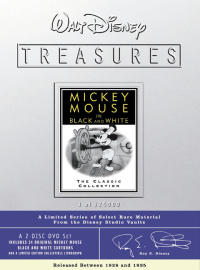Toon Talk: Walt Disney Treasures: Mickey Mouse in Black & White
Page 1 of 2
Toon Talk

Walt Disney Treasures DVD:
Mickey Mouse in Black and White
Two-Toned Toons
The LaughingPlace Store |
Previously available only on laserdisc, the vintage shorts gathered together in Mickey Mouse in Black and White, the first of the three ‘second wave’ of Walt Disney Treasures DVDs, offer an invaluable look back to the genesis of not only the little mouse that could, but also of the Walt Disney Studios as a whole … not for nothing is it known as ‘The Mouse House’.
Leonard Maltin is back, offering insights and back stories on not only the historical significance of these cartoons (presented here in their original forms, unedited and uncensored), but how they should be viewed today, in the cinematic historical context of when they were originally produced. At various points during viewing the shorts, Maltin pops in with commentaries on how such crude gags as Mickey lighting up, chugging a beer or mackin’ on his Minnie (not to mention The Karnival Kid’s Minnie the Shimmy Dancer with her “hoochie-koochie dance” … ) are representative of the unsophisticated humor that was the norm in the cartoons of the 20s and 30s.
Yep, our Mickey was quite a rascal back in the day. And Maltin and the other makers of this collection wisely include a chronological menu of the shorts (as well as an alphabetical listing, but no ‘play all‘ option), so that viewers can see his evolution from the mischievous scamp of Plane Crazy and The Gallopin’ Gaucho, up to his more gentlemanly behavior, starting around The Birthday Party and Mickey Steps Out, and, eventually, to his ‘straight man to Donald and Goofy’ status in Orphan’s Benefit and Mickey’s Service Station, which nicely dove-tails this set into last year’s Mickey Mouse in Living Color collection.

Also included are Maltin’s thoughts on the then common usage of ethnic and racial stereotypes present in a few of these shorts. Again, he states that when these cartoons were first made, such gags as blackfaced characters proclaiming “Mammy!” (a take off on Al Jolson’s famous act) were not considered offensive or morally wrong. Viewed today, some may be shocked by such behavior coming from the corporate symbol of the largest family entertainment empire in the world. But those were different times, and one has to accept that such situations as prejudice and intolerance were a lot more prevalent then, not just in these simple cartoons, but feature films, radio and the world at large. Again, Maltin and his co-producers should be commended for sticking to the artistic integrity of Walt and his artists … now how about doing something similar with Song of the South?
Bonus Feature Highlights:
- In Frank and Ollie … and Mickey, the two surviving ‘Nine Old Men’, Frank Thomas and Ollie Johnson, offer their personal reminiscences of the mouse, from watching the shorts in the theater before they worked for Walt to actually working on them (although it seems they didn’t animated Mickey himself all that much).
- Disc 1 offers still galleries of the Story Scripts, the precursor of storyboards, for Steamboat Willie and Mickey Steps Out, and both discs offer Story Sketch Sequences for selected shorts included in the set.
- Accessible through an ‘Easter egg’ (Mickey’s cowboy hat on the Bonus Features menu) is a look at the original Mickey Mouse Clubs popular in the 30s. Long before the television shows, these clubs were sponsored by neighborhood theaters, where Mickey fans, both young and old, would gather to watch his cartoons. Included is rare footage of Mickey leading club members through a sing-along of his theme song (which is actually just re-used animation from Minnie’s Follies) and a newsreel covering their activities.
- Rarest of all, the only Pencil Test footage of a black and white short known to still exist, for The Mail Pilot, is available on Disc 2.
Toon Talk Rating: A
